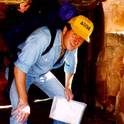The migration behavior of radionuclides in a nuclear-waste repository will be influenced, in part, by their equilibrium solubilities in the presence of radionuclide-bearing solids and/or adsorption affinities as trace components onto the surfaces of solid host phases. Uranium phases that precipitate on the surface of altered spent nuclear fuel may thus influence the mobility of radionuclides released in the near-field environment, since by proximity, these will be the first phases that the radionuclides encounter following their release from the spent fuel matrix. We have evaluated the potential for incorporating radionuclides into crystalline compounds by precipitating uranyl phases from aqueous solutions containing dissolved rare earth elements (REE; 2.1 ppm Ce4+, 4.6 ppm Ce4+, or 286 ppm Nd3+). Rare earth elements serve both as monitors for evaluating the potential behavior of REE radionuclides and as surrogate elements for the actinides (e.g., Ce4+ and Nd3+ for Pu4+ and Am3+, respectively). Although the crystalline compound that formed in the present set of experiments has not been positively identified, x-ray diffraction profiles suggest the presence of a uranyl hydroxide (UO2(OH)2) as the principal reaction product. An analysis of the crystalline products indicate a progressive decrease in concentration of cerium; from 26, to 20, and finally 11 ppm for crystals produced in 7-, 35-, and 190-day tests, respectively (Kd = 14, 11, 3, respectively). Results with neodymium display a similar trend, with concentrations in the solid decreasing from 1240 to 922 ppm between 7 and 35 days of reaction (Kd = 14 and 11, respectively). The decreasing concentration of REEs in the uranyl crystals can be correlated with both a coarsening in crystal size and a decrease in the concentration of dissolved uranium over time. Thus, REE incorporation in the crystalline solids decreases in conjunction with a decrease in the ratio of surface area/volume of the crystals, a decrease in the rate of crystal growth as uranium concentrations are lowered, or both. These data also suggest that adsorption of REE (and by analogy, actinides) onto crystal surfaces and subsequent trapping by crystal overgrowth processes may play key roles in the limiting the mobility of radionuclides in a nuclear waste repository.
- Actinides,
- Adsorption,
- Cerium,
- Crystal Growth,
- Crystalline Materials,
- Neodymium,
- Precipitation (Chemical),
- Radioactive Waste Disposal,
- Radioisotopes,
- Solutions,
- Spent Fuels,
- X Ray Diffraction,
- Crystalline Compounds,
- Nuclear Waste Repository,
- Uranyl Hydroxide Solid,
- Uranium Compounds
Available at: http://works.bepress.com/david-wronkiewicz/46/
